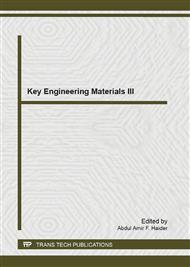p.399
p.403
p.408
p.415
p.420
p.425
p.430
p.435
p.440
Effect of Polycaprolactone Electrospun Fiber Size on L929 Cell Behavior
Abstract:
Poly (caprolactone) (PCL) was selected as the substance for producing the ultrafine fiber using the eletrospinning process. The effect of the solution concentration on fiber size was studied to determine the condition for preparing PCL fiber mats with desired size range. PCL fiber mats with three different fiber sizes, i.e. 440 nm, 960 nm and 4.6 μm, were prepare and used to evaluate effect of fiber size on cell adhesion and proliferation using L929 as a model cell. The results showed that while fiber size has no effect on initial cell attachment, the mat with medium and large fibers showed higher cell proliferation than the mat with small fiber. Fiber size also played role in prohibiting or accommodating cellular distribution or penetration into the under layer of electrospun fiber mat.
Info:
Periodical:
Pages:
420-424
Citation:
Online since:
May 2013
Price:
Сopyright:
© 2013 Trans Tech Publications Ltd. All Rights Reserved
Share:
Citation:


